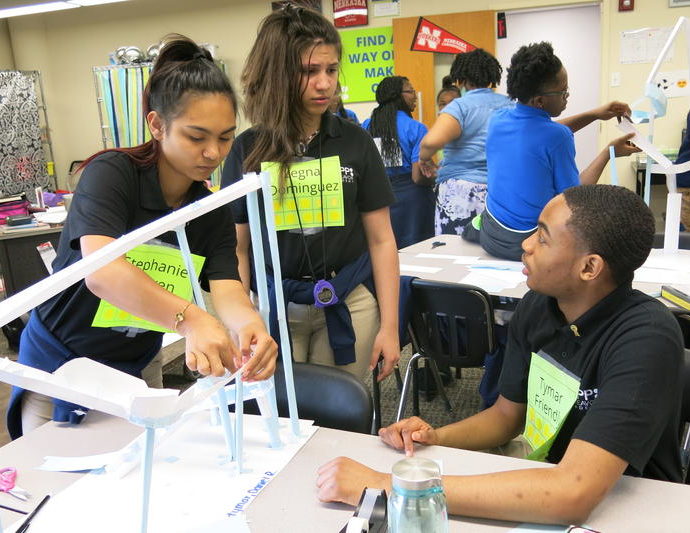In Kansas City, education choices still divide schools by race
ByElle Moxley
Read the full article at KCUR.org >
There are fewer high school age students enrolled in public schools in Kansas City than there are in the elementary grades.
But while charter operators say there aren’t enough high school options, Kansas City Public Schools officials argue there are too many.
Supt. Mark Bedell can’t even keep them all straight. “We have 14 different middle school options – or is it 13?” he asks the district spokeswoman. “Twenty-three. There are 23 different middle school options.” That includes charters. Bedell shakes his head.
Kansas City families don’t make just one school choice. Again and again, year after year, they decide whether to stay or go.
Turns out, a lot of them are going.
Education leaders just aren’t sure where.
Charter perspective
I first met Tymar Friendly back in February, on a school tour for moms with kids about to start kindergarten. His East Side charter school, KIPP Endeavor Academy, was our first stop. We knocked on the door of his language arts classroom.
“Oh my God, that’s a large group,” says a wide-eyed Tymar. He quickly regains composure and introduces himself. He wants to know if we had any questions.
“Do you know where you’re going to high school next year?” Haley Bowman, KIPP’s director of development, asks
“Oh yeah,” he says. “Today, I just got from my teacher, he said I just got accepted to Lincoln.”
“Nice job!” Bowman exclaims. Tymar beams. The moms congratulate him. One of them even went to Lincoln.
“I went to shadow day last Wednesday,” Tymar tells us. “It was amazing.”
I decided it was finally time for me to do a story on how Kansas City families choose high schools. So in May, I went back to KIPP and asked Tymar what he remembered about the day he got into Lincoln.
“When Mr. Swartzlander told me, it actually made me jump two feet into the air,” Tymar recalls.
Tymar’s mom really wanted him to go to Lincoln College Preparatory Academy, an elite district school. After visiting, Tymar really wanted to go there, too. But when I asked Tymar if any of his classmates were headed to Lincoln, he wasn’t sure. That’s because KIPP places eighth graders at so many high schools.
“Sion, at Lincoln, at Cristo Rey,” says Josh Swartzlander, KIPP’s director of high school placement, ticking off each school on his fingers.
Swartzlander is thrilled anytime a kid like Tymar gets an acceptance letter. But the work’s not over. KIPP counselors support students all the way through high school and into college.
“We are literally going into all the buildings across the city to meet with our students,” Swartzlander tells me. “Obviously that’s a logistical challenge that you don’t face when you’re in the same building.”
KIPP opened as a middle school in 2007. Last year it expanded down, to kindergarten. School leaders want to open a high school, but Bowman says the timeline for that is uncertain.
“Our students and families are asking for a high school. We just see a huge need in Kansas City for more free, public schools that are a high academic rigor and quality,” she says.
District pushback
Bedell and other district officials aren’t so sure the answer is more high school seats. When he took the job last year, Bedell promised to work with the charters that compete with KCPS for students. But as more charter school operators have announced their intention to expand, the district has gotten more aggressive about recruitment.
“While there were good intentions with charters, and good intentions with the things we’re doing in our school system, the oversaturation is actually working against all of us because enrollment is down,” Bedell says.
Bedell thinks families are still leaving city schools for big suburban districts like Shawnee Mission and Blue Springs, they’re just putting off the move until their kids are older.
I’ve had families tell me there just aren’t that many options for kids who can’t get into a top school like Lincoln. So I ask the mayor’s education advisor, Julie Holland.
She’s very diplomatic.
“That is a great question, and I think when you’re talking specifically around that topic, you might be talking about families that are on the west side of Troost,” Holland says.
A city divided
Holland says Kansas City is having two conversations about education – one on the economically disadvantaged East Side, and one in more affluent, majority white neighborhoods.
Bottom line, a lot of white families that will send their kids to well-regarded K-8 charters don’t want to enroll them in majority black high schools, which most KCPS neighborhood schools are.
That’s a problem when the research shows socioeconomically diverse schools close the achievement gap fastest, Holland says.
“How do we create schools like that where all kids can benefit, but it’s not something that’s very exclusive, where you’re having to test in, or live in a certain area or affluent neighborhood to have access to it?” she wonders.
Holland says more information is needed about why families leave public schools, whether for private high schools or suburban districts.
“We need to verify with actual interviews, finding these families, asking the question, ‘So why did you leave? Why did you move out at this juncture?’” says Holland.
Her team is trying to do that now.
Meanwhile two charters popular with Brookside families are adding high school seats west of Troost. Academie Lafayette is in talks to buy the old Derrick Thomas Academy, and Crossroads Academy will open its doors to ninth graders this fall.
